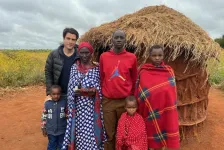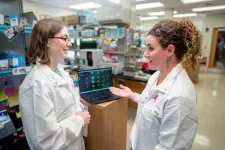(Press-News.org) ITHACA, N.Y. – A study of horses – which share many important similarities with humans in their chromosomes and pregnancies – revealed that 42% of miscarriages and spontaneous abortions in the first two months of pregnancy were due to complications from an extra set of chromosomes, a condition called triploidy.
“Over that embryonic period [up to eight weeks from conception], triploidy had rarely been reported in mammals outside of women,” said Mandi de Mestre, professor of equine medicine at Cornell University. “The study tells us that over the first six weeks of gestation, this will likely be the primary cause of pregnancy loss following natural conception.”
de Mestre is the corresponding author of “Naturally Occurring Horse Model of Miscarriage Reveals Temporal Relationship Between Chromosomal Aberration Type and Point of Lethality,” under embargo until 3pm ET on August 5, 2024 in the Proceedings of the National Academy of Sciences.
Human miscarriages occur in 10-20% of pregnancies and are commonly associated with chromosomal errors, but there have been no suitable animal models that truly duplicate the features of the condition. The new research findings will help veterinarians better understand the causes of pregnancy loss in horses and identifies horses as an excellent model for studying human miscarriage.
“We were able to study the impact of chromosome errors across the entire pregnancy in the horse,” de Mestre said. “We found that triploidy is only associated with losses in early pregnancy.”
In the study, de Mestre’s laboratory at Cornell, and earlier at The Royal Veterinary College, London, received 256 fetus and placenta samples from veterinarians who treated horses with failed pregnancies over a period of 10 years. Using the samples, the researchers were able to investigate the prevalence of different types of chromosomal copy number errors associated with pregnancy loss. They found that chromosomal errors occurred in 57.9% of pregnancy losses up to day 55 of gestation, in 57.2% of losses between days 56 and 110 and in only 1.4% of losses between days 111 and the end of pregnancy. Aneuploidy (loss or gain of a single whole chromosome) was mainly associated with miscarriages in the first 10 weeks of pregnancy, while deletions or duplications of only part of a chromosome were found in miscarriages after 110 days. These findings turned out to be remarkably similar to those observed in a number of large studies in women, according to the paper.
Horses are a good model for studying human pregnancies because they have a similar gestation period – 11 months compared to nine months in women – and the embryo develops at a similar rate in the early stages. In addition, horse chromosomes have a very similar genetic content to human chromosomes, which makes them particularly relevant for the study of chromosome errors.
Reasons for miscarriage in women in very early pregnancy have been difficult to determine because most fetuses during this period are lost at home, leaving scientists without material – and data – to study. The study’s findings provide insight into the frequency of chromosome errors over the equivalent period of the first six weeks of human gestation.
Because of the value of horses and the emotional attachment their owners have to them, horses receive a high level of care, with routine tracking of pregnancies, which then provide extensive data for research.
Other animal models, such as mice, are not comparable to human pregnancies. Mice have a gestation period of about three weeks, and natural pregnancy losses in mice are low.
In terms of equine health, the study provides new details about common chromosomal abnormalities that will likely change the clinical management of pregnancies. For example, if a clinician determines that a horse has a major chromosomal error, they may no longer choose to extend that pregnancy by administering hormones, a common practice in pregnant mares. The study will also point researchers toward the development of new diagnostic tests for chromosome abnormalities in horse fetuses and investigating molecular mechanisms that lead to these abnormalities.
“This research has provided a foundation for understanding the genetic causes of pregnancy loss in horses, often referred to as pregnancy loss of unknown cause,” said Shebl Salem, a postdoctoral researcher in de Mestre’s Equine Pregnancy Lab and a co-first author of the study.
Other co-first authors include Jessica Lawson of the Royal Veterinary College in London, United Kingdom; and Donald Miller, de Mestre lab manager.
The study was partly funded by the Horserace Betting Levy Board and Thoroughbred Breeders Association.
-30-
END
Horse miscarriages offer clues to causes of early human pregnancy loss
2024-08-05
ELSE PRESS RELEASES FROM THIS DATE:
Hydraulic lift technology may have helped build Egypt’s iconic Pyramid of Djoser
2024-08-05
The Pyramid of Djoser, the oldest of Egypt’s iconic pyramids, may have been built with the help of a unique hydraulic lift system, according to a study published August 5, 2024, in the open-access journal PLOS ONE by Xavier Landreau from CEA Paleotechnic Institute, France, and colleagues. The new study suggests that water may have been able to flow into two shafts located inside the pyramid itself, where that water could have been used to help raise and lower a float used to carry the building stones.
The Pyramid of Djoser, also known as the Step Pyramid, is believed ...
Honey added to yogurt supports probiotic cultures for digestive health
2024-08-05
URBANA, Ill. – If you enjoy a bowl of plain yogurt in the morning, adding a spoonful of honey is a delicious way to sweeten your favorite breakfast food. It also supports the probiotic cultures in the popular fermented dairy product, according to two new studies from the University of Illinois Urbana-Champaign.
“We were interested in the culinary pairing of yogurt and honey, which is common in the Mediterranean diet, and how it impacts the gastrointestinal microbiome,” said Hannah Holscher, associate professor in the Department of Food ...
Tradition meets transformation for Maasai women
2024-08-05
Few communities reveal both the challenges and opportunities presented by cultural globalism more than Maasai communities in northern Tanzania. Traditionally pastoralists, the Maasai ethnic group’s social structure is historically patriarchal, with a man’s prestige measured by the size of his family and by the livestock he owns.
The shrinking world has brought change: Urban centers and the promise of jobs are luring young Maasai from communities, and new technologies such as mobile phones are shifting social patterns and structures that ...
Ochsner Health nurses named to the “Great 100 Nurses of Louisiana” 2024 List
2024-08-05
NEW ORLEANS, La. – Ochsner Health proudly announces that 21 Ochsner nurses have been named to the 2024 Great 100 Nurses of Louisiana list by the Great 100 Nurses Foundation. This recognition highlights the contributions and commitment to excellence demonstrated by Ochsner’s nursing staff.
The Great 100 Nurses Foundation was established to honor nurses in Louisiana, North Carolina, Texas and Oklahoma. Each year, the foundation selects 100 nurses throughout Louisiana based on their concern for humanity, ...
Improved chemokine homing enhances CAR T–cell therapy for osteosarcoma
2024-08-05
(MEMPHIS, Tenn. – August 5, 2024) Chimeric antigen receptor (CAR) T–cell immunotherapy re-engineers a patient’s immune cells to target cancer cells. While successful in some types of leukemia, the approach has yet to realize its potential against pediatric solid tumors. Scientists at St. Jude Children’s Research Hospital have identified a way to improve CAR T–cell homing – a T cell’s ability to navigate effectively to a tumor – for osteosarcoma. Improved homing is a necessary step in designing more successful CAR T–cell therapies. The results were published today in Clinical Cancer ...
Forecasting climate’s impact on a debilitating disease
2024-08-05
In Brazil, climate and other human-made environmental changes threaten decades-long efforts to fight a widespread and debilitating parasitic disease. Now, a partnership between researchers from Stanford and Brazil is helping to proactively predict these impacts.
Schistosomiasis, spread by freshwater snails, affects more than 200 million people in many tropical regions of the world. It can cause stomach pain and irreversible consequences such as enlarged liver and cancer. Public health officials worry that deforestation, rapid urban sprawl, and changing rainfall patterns – such as ...
Deaths from advanced lung cancer have dropped significantly since immunotherapy became standard-of-care
2024-08-05
Since the first immunotherapy drug to boost the body’s immune response against advanced lung cancer was introduced in the United States in 2015, survival rates of patients with the disease have improved significantly. That’s the conclusion of a recent real-world study published by Wiley online in CANCER, a peer-reviewed journal of the American Cancer Society.
For the research, a team led by Dipesh Uprety, MD, FACP, of the Barbara Ann Karmanos Cancer Institute and the Wayne State University School of Medicine, analyzed data from the National Cancer Institute Surveillance, Epidemiology, and End Results database, which compiles cancer-related data ...
Air quality regimes around the world are playing catch up as science evolves and policy ambitions are too blunt, researchers say
2024-08-05
The failure to co-ordinate legal, policy and scientific thinking risks “a squandering of opportunity” to improve air quality, concludes new environmental law research, co-led by a UCL academic.
In their Science paper, ‘Harnessing science, policy and law to deliver clean air’, Professors Eloise Scotford (UCL Faculty of Laws), Alastair Lewis (University of York) and Delphine Misonne (UCLouvain Saint-Louis, Brussels) review recent research and highlight significant risks to achieving clean air globally.
Despite significant achievements in air quality law and policy in some parts of the world ...
Engineers develop general, high-speed technology to model, understand catalytic reactions
2024-08-05
AMES, Iowa – Researchers have been studying the industrial production of ammonia for a century. But they’ve struggled to find ways to improve the low-yield, low-efficiency process.
Atmospheric nitrogen, with the aid of an iron catalyst, reacts with hydrogen to produce ammonia. That reaction produces lots of ammonia – worldwide production is 160 million tons every year. Most is used in agriculture, especially as nitrogen fertilizer. It’s also used in many industries, including refrigeration ...
New $1.9 million PSU grant aims to improve outcomes for students with disabilities
2024-08-05
Improving outcomes for students with disabilities as they transition from high school to postsecondary education and employment starts with effective training and development opportunities for the secondary educators who support them.
Portland State University (PSU) has received a $1.9 million grant to redesign, implement and test a professional development model that aims to provide essential training for secondary educators. The grant, awarded by the U.S. Department of Education’s prestigious Institute of Education Sciences, will fund a four-year project titled "Transition Coalition Self-Study Plus (TCSS+): A ...


